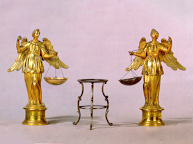
5.5 (diameter of the sieves)
10 (height of the tripod) 21 (height of the angels) INDEX 1788 : A.III.16
Paterae binae, altera ex auro, altera ex ferro multis, et aequalibus pertusae foraminibus Tripodi ferreo impositae, quibus cernitur per poros corporum amplos non transire aliquando materiae particulas multo subtiliores.
Two dishes, one of gold, the other of iron, perforated by many equal holes, placed on an iron tripod, by means of which it can be seen that particles of material do not pass through the large pores of the bodies, sometimes even the most minute.
Gilded bronze, gold and iron
Two sieves, one of gold, the other of iron, are suspended by golden threads from the hands of two winged feminine figures of gilded bronze that were designed for the study of "porosity".
The experiment carried out consisted of pouring a little mercury into each of the sieves. Following this operation, it could be seen that the mercury did not pass through the holes in each of the sieves due to its considerable surface tension. Although the mercury did not pass through the holes in the gold sieve, it was possible, nevertheless, to verify that it infiltrated the metal itself, passing right through it. This experiment was to show the existence of 'pores' in gold, through which mercury could flow. On the other hand, the experiment demonstrated that the passage of particles of mercury through the pores was not exclusively dependent on their dimensions, but also on the nature of the material through which it flowed.
Apart from the winged figures and the sieves, a tripod with two horizontal, parallel rings forms part of the set. These rings are approximately 6 cm apart from each other and their shape suggests that they were designed to support the sieves.
According to Professor Mário Silva, these figures were deposited in the Machado de Castro Museum in Coimbra by Dr. Teixeira Bastos, in the time of António Augusto Gonçalves. During his restoration work at the Gabinete de Física, Professor Mário Silva managed to restore them to the collection of physics instruments, to which they had always belonged. Accordingly, he declares, "The sieves and the tripod were in the Gabinete de Física, the gold sieve well preserved, but the iron one and the tripod only by chance not lost ¬ blackened by years of oxidation, left at the bottom of a cupboard, they were mixed up with valueless scrap metal."
From Colégio dos Nobres, catalogue n.º 16.
Silva, Mário da, "Um Novo Museu em Coimbra: O Museu Pombalino da Faculdade de Ciências da Universidade", Revista da Faculdade de Ciências da Universidade de Coimbra, n.º 1, Vol. VIII, pp. 129-154.